Backing up QuickBooks is (not that) hard to do
The guiding rule is that you back up any time you work on something that you wouldn’t want to redo. Some people think that a week’s worth of work is negligible; others think that a month’s worth of work is negligible.
Here’s what this author does to back up her files. She backs up every week after she enters her data for the week. Then she sticks the disc (you might use any removable disc, such as a USB flash drive or a writable CD) in her briefcase so that if something terrible happens (like a meteor hitting the office building), she doesn't lose both her computer and the backup disc with the data.Sounds like a pretty good system, huh? Actually, this strategy has its problems:
- Because she backs up weekly, she may have to re-enter as much as a week’s worth of data if the computer crashes toward the end of the week. If you’re someone with heavy transaction volumes — if you prepare hundreds of invoices or write hundreds of checks each week, for example — you probably want to back up more frequently, perhaps every day.
- A second problem with my strategy is only remotely possible but still worth mentioning: If something bad happens to the QuickBooks files stored on the computer’s hard drive as well as the files stored on the backup flash drive, CD-R, CD-RW, or some other removable data-storage device, she'd be up the proverbial creek without a paddle. (A removable disc is far more likely to fail than a hard drive and is easier to lose.) If this worst-case scenario actually occurs, she’ll need to start over from scratch from the beginning of the year.
Say you back up your data every week, and your hard drive not only crashes, but also bursts into a ball of flames rising high into the night. To restore your files, you use the most recent set of backups — one week old, max. If something is wrong with those files, you use the next–most-recent set — two weeks old. If something is wrong with those files, you use the last set — three weeks old. This way, you have three chances to get a set that works — a nice bit of security for the cost of a few extra discs or storage devices.
Two final comments related to backup strategies and tactics:
- QuickBooks supplies an online backup tool that you can also use to reduce the risks of losing your data if you lose your backup copy. If you’re really concerned about data safety, and you have an extra $100 to $200 a year, you may want to regularly (daily?) use the QuickBooks online backup service.
- You may be able to combine your backup of your QuickBooks data with your other backup method. This method might be another manual option in which you copy files to a removable storage device like the one she uses. Or you may be able to employ another online backup system such as Carbonite, which uses an automatic system to secure all your data.
Backing up the quick-and-dirty way
You’re busy. You don’t have time to fool around. You just want to do a passable job of backing up, and you’ve decided how often you plan to do it. Sound like your situation? Then follow these steps:1. Insert a blank disc into the appropriate drive, or connect a USB storage device.
You can back up to any removable disc, including flash memory devices, portable hard disks, and writable CDs. Note, however, that Intuit (the maker of QuickBooks) recommends that you not use the QuickBooks backup command to move a backup file onto a CD. Instead, it recommends that you back up the file to your hard drive and then use the Windows file-copy command to burn the file onto the disc. This work-around approach tends to solve some of the CD-writing problems that people experience when backing up directly to a CD from QuickBooks.
Heck, she should admit that you can back up to any fixed disk, such as your hard drive or a network disk, but the advantage of a removable disc is that you can store it in some other location. As a compromise, you can use a network disk. You typically don’t want to use your hard drive (although it’s better than nothing) because one of the disasters that could befall your QuickBooks data is a hard drive failure.
You can also back up your QuickBooks files to an online storage area.
2. If you store data for more than one company, make sure that the company whose data you want to back up is the active company.You want to back up the correct company. To find out whether the correct company is active, look at the QuickBooks application window’s title bar, which names the active company. (If you don’t remember setting up multiple files, don’t worry. You probably have only one file — the usual case.)
If you use QuickBooks in multiuser mode, you need to switch to single-user mode before you back up your file. To do this, choose File→Switch to Single-User Mode.
3. Choose File → Backup Company→ Create Local Backup to begin the backup operation.QuickBooks displays the Create Backup dialog box.
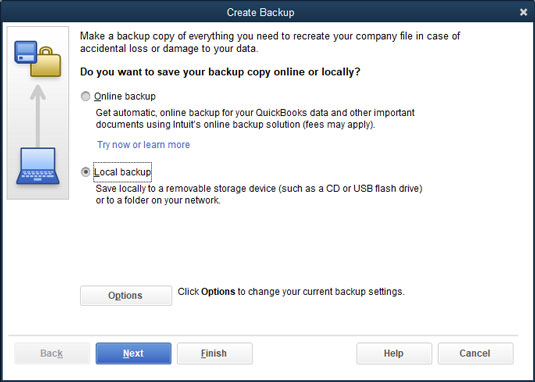 The Create Backup dialog box.
The Create Backup dialog box.4. Tell QuickBooks where you want to back up the QuickBooks data file.
When QuickBooks displays the Create Backup dialog box — the one shown— specify the location for the backup by selecting the Online Backup or Local Backup radio button.
To back up your QuickBooks file locally select the Local Backup option.
5. Describe how QuickBooks should back up your data file. The Backup Options dialog box.
The Backup Options dialog box.With the first Create Backup dialog box still displayed, click the Options button. QuickBooks displays the Backup Options dialog box, where you specify how and when QuickBooks backs up your data file:
- Pick a default location. Specify where the backup file should be located. You can do this either by entering the pathname of the backup folder in the Tell Us Where to Save Your Backup Copies box (the hard way) or by clicking the Browse button and then using the Browse for Folder dialog box that Windows displays to pick a default backup location.
- Fine-tune the backup operation. The Backup Options dialog box provides a few check boxes that you can use to fine-tune the old QuickBooks backup operation. The check box titled Add the Date and Time of Backup to the File Name, if selected, does just what it says. The check box titled Limit the Number of Backup Copies in This Folder To [X> tells QuickBooks to limit the number of backup copies of your QuickBooks file it stores in the backup folder. The default number of backup copies kept on hand is three, which should be fine.
- Specify the backup reminder rule. You can select the check box titled Remind Me to Back Up When I Close My Company File Every [X> Times to tell QuickBooks to remind you every so often to back up. By default, QuickBooks reminds you every fourth time you close a data file, but you can replace the value in the text box to specify some other backup-reminder frequency.
- Select a data verification option. QuickBooks provides three data verification options: Complete Verification (safe but slow), Quicker Verification (fast but not as thorough), and No Verification (saves you a bit of time now at the risk of huge problems later). The Complete Verification option is what QuickBooks and I both recommend.
When you finish with the Backup Options dialog box, click OK and then click Next. QuickBooks displays the second Create Backup dialog box.
 The second Create Backup dialog box.
The second Create Backup dialog box.6. Determine when QuickBooks should back up your data file.
The second Backup Wizard dialog box provides option buttons that you use to schedule when you want to back up. To indicate that you want to back up on the spot, select the Save It Now radio button.
Note: The very, and I mean the very, first time you back up your QuickBooks file by using the Create Backup command, QuickBooks doesn’t ask you when it should back up your data file. It just backs up the data file, skipping this step.
7. Confirm the backup file location and name.With the second Backup Wizard dialog box displayed, click Next. QuickBooks displays the Save Backup Copy dialog box. If you successfully completed Step 5, you’ve already specified the appropriate folder location for the backup file. Just to be on the safe side, confirm that the filename and folder location shown in the Save Backup Copy dialog box are correct. If the folder location isn’t correct, choose a new folder location from the Save In drop-down menu. If the filename isn’t correct, edit the name shown in the File Name text box.
 The Save Backup Copy dialog box.
The Save Backup Copy dialog box.8. Click Save.
QuickBooks backs up your data file and displays a message box telling you that it has backed up your file. The message also gives the backup filename and folder location.
Backing up QuickBook files online
You can back up your data online quickly and easily. If you do so, you no longer need to remember to make backups and take them offsite. To find out more about online backup, choose File→ Create Backup and then click the Learn More about QuickBooks Online Backup link.The Online Backup service is a pretty darn good idea if you have a fast Internet connection, but the service costs a little bit of money. Depending on the level of service, you pay at least $100 to $200 per year, but you can set up the service so that QuickBooks automatically backs up your data and even other important files on a regular basis.
Two final points about using the QuickBooks online backup option:
- Just for the record, you need to worry about security. (You can read more about the security measures on the QuickBooks website, but your data is as secure online as it is in your office.)
- Most folks should use the serviceOnline offsite backup at the prices that Intuit offers seems like a really excellent deal for any business in which the QuickBooks data files are important.
Getting back the QuickBooks data you backed up
What happens if you lose all your QuickBooks data? First of all, I encourage you to feel smug. Get a cup of coffee. Lean back in your chair. Gloat for a couple of minutes. You, my friend, have no problem. You followed instructions.Okay, you may have one or two problems, but you can probably blame PC gremlins for those. If the disaster that caused you to lose your data also trashed other parts of your computer, you may need to reinstall QuickBooks. You also may need to reinstall all your other software.
After you gloat sufficiently (and piece your computer back together again, if it was the cause of the disaster), carefully do the following to reinstate your QuickBooks data:1. Get your backup files.
Find the backup you created, and load it into the appropriate drive (for a disc) or USB port (for a thumb drive or external source). If you’re working with an external disk, do anything special you need to do to access that device, such as turn on the external disk’s power.
2. Start QuickBooks, and choose File→ Open or Restore Company.QuickBooks displays the Open or Restore Company dialog box.
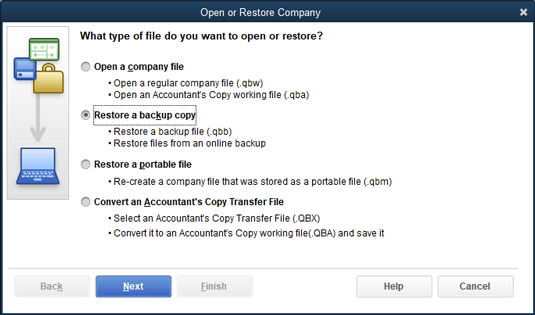 The Open or Restore Company dialog box.
The Open or Restore Company dialog box.3. Indicate that you want to restore a backup copy of your QuickBooks data file; then click Next.
How you do this is obvious, right? Select the Restore a Backup Copy radio button.
4. Tell QuickBooks whether you backed up locally or online; then click Next.QuickBooks displays the Open or Restore Company dialog box (not shown).
5. Select the Local Backup option button to indicate that you made a local backup, and then click Next.6. Identify the backup file that you want to use; then click Open.
QuickBooks displays the Open Backup Copy dialog box. If you know the company filename and location, you can enter this information in the boxes provided. If you don’t know this information, use the Look In drop-down menu to identify the drive that contains the file you want to back up; then choose the backup file you want to restore, and click Open. QuickBooks displays the Open or Restore Company dialog box (not shown), telling you that the next step (where you specify the restoration location) is pretty darn important.
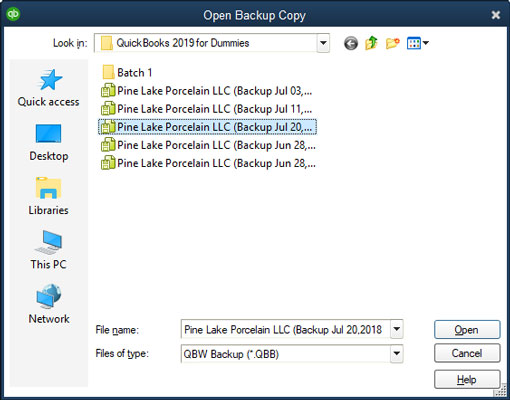 The Open Backup Copy dialog box.
The Open Backup Copy dialog box.7. Specify where the restored file will be located; then click Next again.
QuickBooks displays the Save Company File As dialog box. Use the File Name text box and Save In drop-down menu here to identify the file you want to replace.
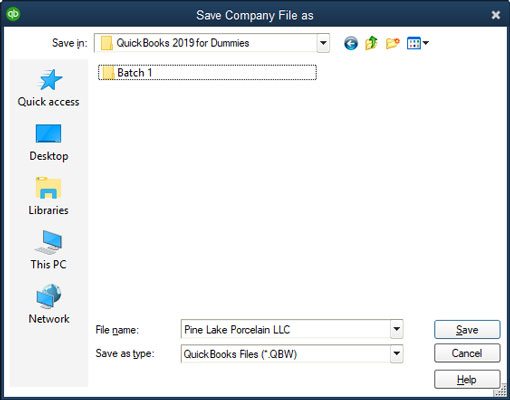 The Save Company File As dialog box.
The Save Company File As dialog box.If you know the company filename and location, you can enter this information in the text boxes provided. If you don’t know this information, use the Save In drop-down menu to make sure that you place the restored file in the correct folder on the correct drive.
8. Click Save.If the file you’re trying to restore already exists, you see a message box telling you so.
9. Click Yes to overwrite and replace the file with the one stored on the backup disc, or click No to keep the original copy.QuickBooks may ask you for your password to verify that you have administrative permission to restore the file. Then, if everything goes okay, you see a message box that says so. Breathe a deep sigh of relief, and give thanks.
When you restore a file, you replace the current version of the file with the backup version stored on the backup medium. Don’t restore a file for fun. Restore a file only if the current version is trashed and you want to start over by using the version stored on the backup disc.
You need to re-enter everything you entered since you made the backup copy. You’re bummed out. With luck, it hasn’t been all that long since you backed up.
Using the Accountant’s Copy
While I’m on the subject of the housecleaning stuff that you can do with your QuickBooks files, I’ll mention the Accountant’s Copy feature.Let me start by saying that I don’t really like this feature. In my experience — and my firm serves hundreds of small businesses using QuickBooks — the Accountant’s Copy doesn’t work that well in practice. But you may want to try it anyway.
An Accountant’s Copy allows your accountant to make adjustments in a special copy of your QuickBooks data file while you continue to enter your daily transactions in the master file. When your accountant returns the updated file, you can merge the changes back into the master file.
To use the Accountant’s Copy feature, choose File→ Create Copy. Select the Accountant’s Copy option and then follow the onscreen instructions. You can import the accountant’s changes later. If you need help with this feature, talk to your accountant.
You should never upgrade to a newer version of QuickBooks while your accountant is still working with the Accountant’s Copy. At least, you shouldn’t do this if you plan on using the accountant’s changes. If an active Accountant’s Copy is in use, your screen will state that fact at the very top, next to the company name.
Working with Portable Files
QuickBooks includes a portable-files feature. A portable file is a smaller, condensed version of the QuickBooks data file. The portable file is small enough, in fact, that you can probably email it to your accountant, your sister in Portland, or me.To create a portable file, choose File →Create Copy. When QuickBooks displays the first Save Copy or Backup dialog box, select the Portable Company File option button, click Next, and then follow the onscreen instructions. The process, by the way, resembles the backup process. I find it really easy to save the file on the desktop. Then you can attach it easily to your email and send it out. After the other party receives the file, you can drag your copy to the Recycle Bin. Your real file remains intact. (A portable file typically must be 10MB or smaller for transmission through most email services.)
To open a portable file, a person (this could be your accountant, your sister in Portland, or me) should choose File→ Open or Restore Company. When QuickBooks displays the Open or Restore Company dialog box, this other person just specifies the file that she wants to open as a portable file and then follows the onscreen instructions.
Using an Audit Trail
For some curious reason, in the post–Bernie Madoff world of accounting, people are much more interested in the QuickBooks Audit Trail feature. Because of this renewed interest, let me share the three things you need to know about using the QuickBooks Audit Trail feature:- An audit trail is simply a list of changes. The QuickBooks Audit Trail — which is a simple report that lists the changes in the QuickBooks data file — lets you see who changed what.
- You can’t turn off the Audit Trail feature in recent versions of QuickBooks. Accordingly, every change you make (or that someone else in your office makes) in QuickBooks is recorded.
- You can print the Audit Trail report by choosing Reports → Accountant & Taxes→ Audit Trail.
Using a Closing Password
QuickBooks doesn’t require you to — or even let you — “close” months and years, the way old manual accounting systems did. (When you “closed” an old accounting period, you actually zeroed out the revenue and expense accounts and then transferred the net amount to the owner’s equity accounts.)QuickBooks does let you use a closing date and password, however. The closing date sort of prevents someone from entering transactions earlier than the specified date. If you set a closing password, for example, someone needs to supply that password before entering a transaction or changing a transaction dated before the closing date. If you don’t set a closing password, someone trying to enter or change a transaction dated before the closing date is warned, but that person can still create or change the entry.
To set a closing date, choose Edit→ Preferences, click the Accounting icon, click the Company Preferences tab, and then click the Set Date/Password button so that QuickBooks displays the Set Closing Date and Password dialog box. You enter the closing date (probably the end of the most recently completed year) in the Closing Date text box and then enter the password (twice): in the Closing Date Password text box and in the Confirm Password text box. Note: Select the check box titled Exclude Estimates, Sales Orders and Purchase Orders from Closing Date Restrictions so that you don’t lose access to these transactions as part of the closing.
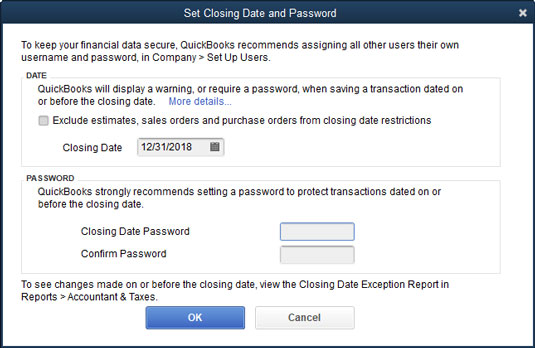 The Set Closing Date and Password dialog box.
The Set Closing Date and Password dialog box.Don’t set a closing date and password on a QuickBooks file you want to send to your accountant so he or she can prepare your tax return. Your tax accountant will probably need to make changes in your QuickBooks file to sync things between your records and your tax return. You want to “lock” the preceding year only after your tax return is complete.





